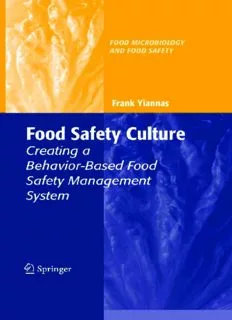
Food Safety Culture: Creating a Behavior-Based Food Safety Management System PDF
Preview Food Safety Culture: Creating a Behavior-Based Food Safety Management System
Food Safety Culture Food Microbiology and Food Safety Series FoodMicrobiologyandFoodSafetypublishesvaluable,practical, andtimelyresourcesforprofessionalsandresearchersworkingon microbiologicaltopicsassociatedwithfoods,aswellasfoodsafety issuesandproblems. Series Editor MichaelP.Doyle,RegentsProfessorandDirectoroftheCenterforFood Safety,UniversityofGeorgia,Griffith,GA,USA Editorial Board FrancisF.Busta,Director,NationalCenterforFoodProtectionand Defense,UniversityofMinnesota,Minneapolis,MN,USA BruceR.Cords,VicePresident,Environment,FoodSafety&Public Health,EcolabInc.,St.Paul,MN,USA CatherineW.Donnelly,ProfessorofNutritionandFoodScience, UniversityofVermont,Burlington,VT,USA PaulA.Hall,President,AIVMicrobiologyandFoodSafetyConsultants, LLC,HawthornWoods,IL,USA AilsaD.Hocking,ChiefResearchScientist,CSIRO—FoodScience Australia,NorthRyde,Australia ThomasJ.Montville,ProfessorofFoodMicrobiology,Rutgers University,NewBrunswick,NJ,USA R.BruceTompkin,FormerlyVicePresident-ProductSafety,ConAgra RefrigeratedPreparedFoods,DownersGrove,IL,USA Titles EffectiveRiskCommunication:AMessage-CenteredApproach, TimothyL.Sellnow,RobertR.Ulmer,MatthewW.Seeger, RobertS.Littlefield(Eds.)(2009) FoodSafetyCulture,FrankYiannas(2008) MolecularTechniquesintheMicrobialEcologyofFermentedFoods,Luca CocolinandDaniloErcolini(Eds.)(2008) VirusesinFoods,SagarM.Goyal(Ed.)(2006) FoodborneParasites,YnesR.Ortega(Ed.)(2006) PCRMethodsinFoods,JohnMaurer(Ed.)(2006) Frank Yiannas Food Safety Culture Creating a Behavior-Based Food Safety Management System 1 3 FrankYiannas Bentonville,Arkansas USA [email protected] ISBN:978-0-387-72866-7 e-ISBN:978-0-387-72867-4 DOI10.1007/978-0-387-72867-4 LibraryofCongressControlNumber:2008935903 #2009SpringerScienceþBusinessMedia,LLC Allrightsreserved.Thisworkmaynotbetranslatedorcopiedinwholeorinpartwithoutthewritten permissionofthepublisher(SpringerScienceþBusinessMedia,LLC,233SpringStreet,NewYork, NY10013,USA),exceptforbriefexcerptsinconnectionwithreviewsorscholarlyanalysis.Usein connectionwithanyformofinformationstorageandretrieval,electronicadaptation,computer software,orbysimilarordissimilarmethodologynowknownorhereafterdevelopedisforbidden. Theuseinthispublicationoftradenames,trademarks,servicemarks,andsimilarterms,evenifthey arenotidentifiedassuch,isnottobetakenasanexpressionofopinionastowhetherornottheyare subjecttoproprietaryrights. Printedonacid-freepaper springer.com This book is dedicated to my parents, Haralambos and Daisy Yiannas, for teaching me through their example and not just words, the importance of a strong work ethic and always searching for a better way. Contents 1 LookingBacktoShapetheFuture........................... 1 HistoryofFoodProduction............................... 1 EmergenceofRetailFoodEstablishments.................... 3 FoodborneDisease...................................... 4 RetailFoodSafety ...................................... 6 ReducingRiskEarlyintheFoodProductionChain .......... 6 ChangingBehavior .................................... 8 KeyPoints............................................. 9 2 WhytheFocusonCulture?................................. 11 WhatIsCulture?........................................ 11 WhyIsCultureImportant?................................ 12 WhoCreatesCulture?.................................... 13 HowIsCultureCreated?.................................. 14 TheFoundation ........................................ 15 CoreElements.......................................... 15 LeadershipattheTop.................................. 16 ConfidenceinthePartofAllEmployees ................... 16 ClearManagementVisibilityandLeadership................ 16 AccountabilityatAllLevels ............................. 17 SharingofKnowledgeandInformation.................... 17 BestPractices........................................... 17 KeyPoints............................................. 18 3 ASystems-BasedApproachtoFoodSafety.................... 21 WhatIsaSystem?....................................... 22 SystemsThinking ....................................... 22 BehaviorChangeTheoriesandModels ...................... 23 BehavioralTheory..................................... 23 SocialCognitiveTheory ................................ 23 HealthBeliefModel ................................... 24 TheoryofReasonedAction ............................. 24 vii viii Contents TranstheoreticalModel................................. 24 SocialMarketing...................................... 25 EnvironmentalorPhysicalFactors.......................... 25 ABehavior-BasedSystemsContinuousImprovementModel..... 27 KeyPoints............................................. 28 4 CreatingFoodSafetyPerformanceExpectations................ 29 GettingEmployeestoDoWhatTheyAreSupposedtoDo....... 29 ExpectMorethanEfficiency............................... 30 ExpectaProperFoodSafetyAttitude ....................... 31 BeSpecific–NotGeneric................................. 31 StartwiththeFoodCode ................................. 32 DevelopRisk-BasedExpectations .......................... 32 BeyondRegulatoryCompliance............................ 34 WriteThemAllDown ................................... 35 KeyPoints............................................. 36 5 EducatingandTrainingtoInfluenceBehavior .................. 39 EducationVersusTraining................................ 40 WhyEducateandTrain?.................................. 41 FocusonChangingBehavior .............................. 42 MakeItRisk-Based ..................................... 44 ValueandRespectDiversity............................... 44 KeepItSimpleandUserFriendly .......................... 45 KeyPoints............................................. 46 6 CommunicatingFoodSafetyEffectively ...................... 49 TheImportanceofCommunication......................... 49 UseaVarietyofMediums ................................ 50 Posters,Symbols,andSlogans ............................. 51 UseMorethanWords.................................... 51 HaveConversations ..................................... 52 AskQuestions.......................................... 54 KeyPoints............................................. 55 7 DevelopingFoodSafetyGoalsandMeasurements............... 57 TheImportanceofFoodSafetyGoalSetting.................. 57 EstablishingEffectiveFoodSafetyGoals..................... 58 WhyMeasureFoodSafety? ............................... 59 WhatShouldYouMeasure?............................... 61 LaggingVersusLeadingIndicatorsofFoodSafety............. 62 KeyPoints............................................. 65 Contents ix 8 UsingConsequencestoIncreaseorDecreaseBehaviors........... 67 DeterminetheCauseofPerformanceProblems................ 68 CreatingConsequencesforFoodSafety...................... 69 PositiveConsequences.................................... 70 NegativeConsequences................................... 73 KeyPoints............................................. 74 9 TyingItAllTogether–Behavior-BasedFoodSafetyManagement.. 77 ManagementorLeadership?............................... 77 TraditionalFoodSafetyManagementVersusBehavior-Based FoodSafetyManagement................................. 78 10 Unwrapping–ThoughtsontheFutureofFoodSafety............ 83 TheWayForward?...................................... 83 MakingSignificantLeaps................................. 84 TheFuture ............................................ 85 References................................................. 87 Index..................................................... 91 Introduction Ithasbeensaid,whatweknowandwhatwebelieveisoflittleconsequence.Itis whatwedothatisimportant.Whenitcomestofoodsafety,thispointiscertainly true. ThemainreasonIdecidedtowritethisbookissimple.It’sbecauseIwishI couldhaveknown20yearsago(whenIstartedmycareerinfoodsafety)whatI know now. The concepts I will share with you in this book are not generally taughtinfoodsciencecurriculums.Theyarenotsomethingyougenerallyhear aboutinfoodsafetyseminarsoratfoodsafetyconferences.Tomyknowledge, thereisnotmuchdocumentedinthefoodsafetyliteratureaboutthistopic. The concepts you’ll read about in this book are simple. Many are age-old principles abouthumanbehavior.Othersaremore recent conceptsdeveloped through the study of human behavior, group dynamics, and organizational culture.Manyoftheideas maybeconsideredsimple.Theyaresosimplethat they are powerful. In fact, one of the most common compliments I receive is that the ideas presented in this text are simple, but they are rarely assembled togetherinthismannerandtheyarerarelyusedinthecontextofimprovedfood safetyperformance. In the field of food safety today, there is much documented about specific microbes, time/temperature processes, post-process contamination, and HACCP – things often called the hard sciences. There is not much published or discussed related to human behavior and culture – often referred to as the ‘‘softstuff.’’ However,ifyoulookatfoodbornediseasetrendsoverthepastfewdecades, it’scleartomethatthesoftstuffisstillthehardstuff.Wewon’tmakedramatic improvementsinreducingtheglobalburdenoffoodbornedisease,especiallyin certainpartsofthefoodsystemandworld,untilwegetmuchbetteratinfluen- cingandchanginghumanbehavior(thesoftstuff). Despitethefactthatthousandsofemployeeshavebeentrainedinfoodsafety around the world, millions have been spent globally on food safety research, andcountlessinspectionsandtestshavebeenperformedathomeandabroad, food safety remains a significant public health challenge. Why is that? The answer to this question reminds me of a quote by Elliot M. Estes, who said, ‘‘Ifsomethinghasbeendoneaparticularwayfor15or20years,it’saprettygood xi
Description: